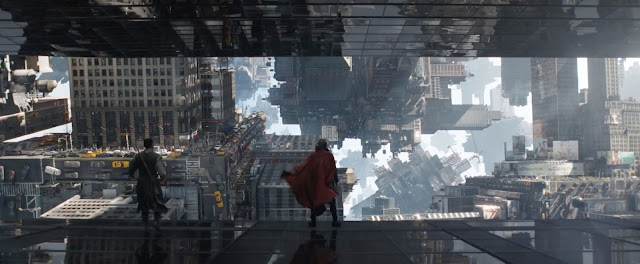'Try Me, Beyonce' | Doctor Strange - Film Review
Stephen Strange (Benedict Cumberbatch) is a New York-based neurosurgeon - not the singer from 80’s New Romantic band Visage - with ego issues who gets his hands severely broken in a car accident. After several failed operations to fully repair his mitts, Strange seeks other options and learns of Kamar-Taj, a distant place of spiritual healing.
Travelling to Kathmandu, he is introduced to a mystical reality he never believed existed by the Ancient One (Tilda Swinton) and her assistant, Mordo (Chiwetel Ejiofor). Soon, he meets Kaecilius (Mads Mikkelsen, playing another villain with eye trauma, after starring as Le Chiffre in Casino Royale), an ex Kamar-Taj student with an even bigger ego than Strange’s and a deadly plan to match. It’s up to Strange and his friends to stop Kaecilius before he alters reality forever.
An article about this film on Christian media watch website, Movieguide, called it a ‘dangerous introduction to the occult’ in its depiction of ’false spiritual notions’, citing the biblical values Movieguide seeks to promote as ‘truth, love, compassion, sacrifice, justice, and forgiveness’, Most, if not all, of these are present in Doctor Strange. Director and co-writer, Scott Derrickson, is himself a Christian, so it’s unlikely that he would present a worldview that contradicts his own. In order to progress in his sorcerer training, Strange must learn humility. How much more of a selfless, Christian-themed message can you get than, ‘it’s not about you’?
Thankfully, in Doctor Strange, there was nothing in all in its architecture-rebuilding, wall-walking, spell-casting, astral projecting, time warping, dimension-traversing antics that either threatened my own sanity or faith. The most disturbing images in the film were realistic portrayals of serious hand and back injuries that (mostly) have nothing to do with magic.
The fact that I’d seen versions of a lot of the film’s concepts before probably helped. There are whole cities bending in on themselves in Inception (although there’s more intricate architectural effects in Doctor Strange), trippy, transcendent space travel in 2001 and Interstellar (Christopher Nolan’s work seems to be very influential, here), David Bowie walking around gravity-defying Escher-like structures in Labyrinth; whereas The Mighty Boosh, Cyriak’s surreal videos and U2’s video for Even Better Than The Real Thing depict fractal infinities of the kind we see during a sequence where Strange tumbles through the astral plane. Events also get rather timey-wimey, as per Doctor Who and the ending of 1978’s Superman: The Movie, albeit by a different method.
For a superhero film, Doctor Strange is visually audacious and it’s all done beautifully. I was particularly impressed by a scene where reality slows around two characters talking in their astral forms. A lightening strike from the storm raging aorund them crawls gracefully across the sky, as the pair talk. It’s a simpler effect than during the fight scenes, but that’s part of its beauty.
The effects blend well with the story, rather than overshadowing it. However, whilst engrossing, the narrative is pretty much the same as that of The Shadow (1994), where - spoilers - Alec Baldwin plays the arrogant American humbled and taught superpowers by an Eastern mystic, who is then killed by a former pupil gone bad. Baldwin must then use his powers to stop his evil fellow pupil’s world-threatening plan. Batman Begins (Nolan again) also had a similar story, although, overall, Doctor Strange far outranks the former and is arguably better than the latter. The climax of Doctor Strange is essentially the same as with any other Marvel movie, with our heroes having to prevent an otherworldly force attacking a major city, just with added timey-wimey, wibbly-wobbly stuff.
Thanks to writers Jon Spaihts (Prometheus) Scott Derrickson and C. Robert Cargill, Doctor Strange is also very witty, helping to ground one of Marvel’s more outlandish characters (which is saying something), who could potentially have looked silly, onscreen. ‘Try me, Beyonce!’ is possibly the best line in the film. Strange says it to Kamar-Taj librarian Wong (played by Cumberbatch’s fellow Benedict, Benedict Wong, who was surely cast on more of a basis than his surname being the same as his character’s?) His single moniker causes the good Doctor some amusement. Wong clearly spends too much time amongst his books and this magical library does not have a popular music section, so he’s presumably never even heard of Beyoncé. It’s odd hearing the names of real-world celebrities in a superhero film but I suppose it's a way of grounding a potentially daft-looking character in our ‘reality’.
During one of the obligatory end credit scenes, Strange speaks to an Avenger who is not Tony Stark, played by Benedict Cumberbatch’s fellow Sherlock Holmes, Robert Downey Jr. It might've been a cute, metatextual nod to feature two Sherlocks in one film, a melding of different fictional realities. Audiences had to wait until Avengers: Infinity War for that one. Nor does Strange meet NSA agent and Black Panther ally, Everett K. Ross, whom we first met in Captain America: Civil War, played by Martin Freeman, who, of course, also plays John Watson, opposite Cumberbatch, in Sherlock. Maybe combining franchises like this in a character's origin story would have been traversing one dimension too far?
Strange soon educates Wong, allowing himself to sneak books out whilst Wong is distracted. Of all the characters, Tilda Swinton’s Ancient One was the most intriguing. Where did she get her head scars? Was she, like Strange, also inducted into the mystic arts via a search for physical healing?
Doctor Strange is visually bold for a Marvel movie, if not narratively. The script and direction altogether bring one of the comics' wackier characters to life in a cool, believable way.
Images courtesy of IMDb and C. Scott Cargill's Twitter. Thanks, C.






Comments
Post a Comment